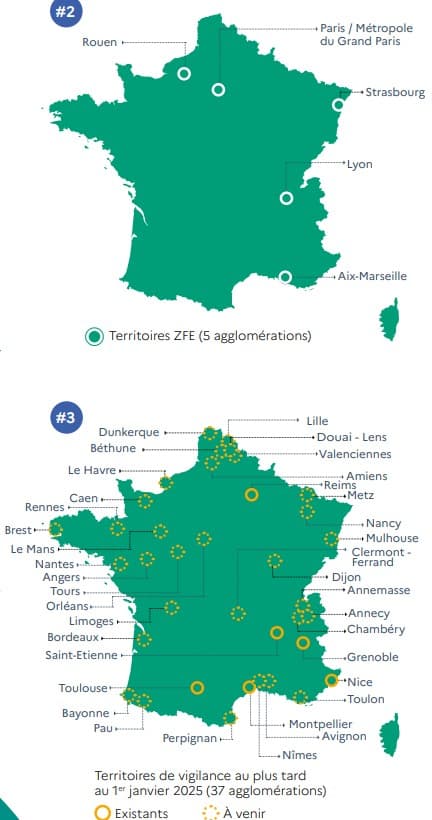The Ministerial Committee for “Air Quality in the City” published on Monday an expected report on the ZFE, these low emission zones installed in several cities to reduce the carbon footprint of cars. These free zones give rise to traffic restrictions. Heterogeneous restrictions depending on the cities in question.
The report welcomes “an air quality that has been gradually improving over several decades”, especially in Toulouse, Grenoble and Reims.
But given the criticisms raised by both professionals in the sector, the fears of many citizens before a circulation ban or the questions of many elected officials, the Government has decided to review its copy.
While by 2025, 42 cities with more than 150,000 inhabitants were going to initially establish ZFIs (11 have already established them), the Government now establishes the distinction between “two types of territories”, depending on whether or not they respect the regulatory thresholds for air quality : cities “in surveillance zones” and “ZFE territories”.
37 cities in “surveillance zone”
For the former, the scheduled restrictions are revised downward or postponed.
For the conurbations that have not yet implemented rules (31 conurbations involved) the only obligation provided by law is the restriction of movement of cars registered until December 31, 1996 (unclassified) before January 1, 2025. larger vehicles 25 years old.
In the case of the agglomerations in which ZFEs already exist (6 agglomerations in question: Reims, Saint-Étienne, Grenoble, Nice, Montpellier and Toulouse) “all have established at least the minimum restrictions provided by law. Therefore, They no longer have any obligation to tighten their current restrictions,” read the ministry’s press dossier.
Example in Reims: the circulation of Crit’Air 3 vehicles (petrol vehicles over 19 years old and diesel vehicles over 14 years old) should have been limited there from January 1, 2024, but this will not be the case. In view of the 2022 figures published by Citepa, an association whose data is reliable, AFP recalls that “Reims no longer regularly exceeds the regulatory air quality thresholds,” said the Ministry of Ecology.

Five cities in “ZFE territories”, including Paris
Finally, only five metropolises remain in “EPZ territories” because they still “regularly” (ie three years out of the last five years) exceed regulatory air quality thresholds. These are Paris, Lyon, Aix-Marseille, Rouen and Strasbourg. And in these cities, the restrictions must continue.
Therefore, they must continue to gradually apply the restrictions established by law:
- Crit’Air 4 ban from January 1, 2024 (diesel cars over 18 years old),
- then Crit’Air 3 in 2025 (diesel cars over 14 years old and gasoline cars over 19 years old).
New exemptions
But these cities benefit from some additional exemptions, which in particular must allow professionals to continue moving.
“He (the city, editor’s note), on the other hand, has no legal obligation to schedule with respect to HGVs, two-wheelers, light commercial vehicles (ULVs) or Crit’Air 2 restrictions (diesel vehicles, editor’s note) regardless of the vehicle ”, specifies the ministry.
The municipality can also change the application parameters of the ZFE: the exceptions granted, the time slots or even “establish a pass that authorizes a certain number of steps for vehicles subject to circulation restrictions.” In short, part-time EPZs.
These decisions confirm the idea that the government intends to calm the discontent caused by the establishment of these EPZs, which are often complex and misunderstood or too well understood, and shunned by motorists.
Initially, these restrictions were going to be applied in 2025 in 43 agglomerations, that is, 34% of the vehicle fleet in circulation in 2022.
Source: BFM TV

